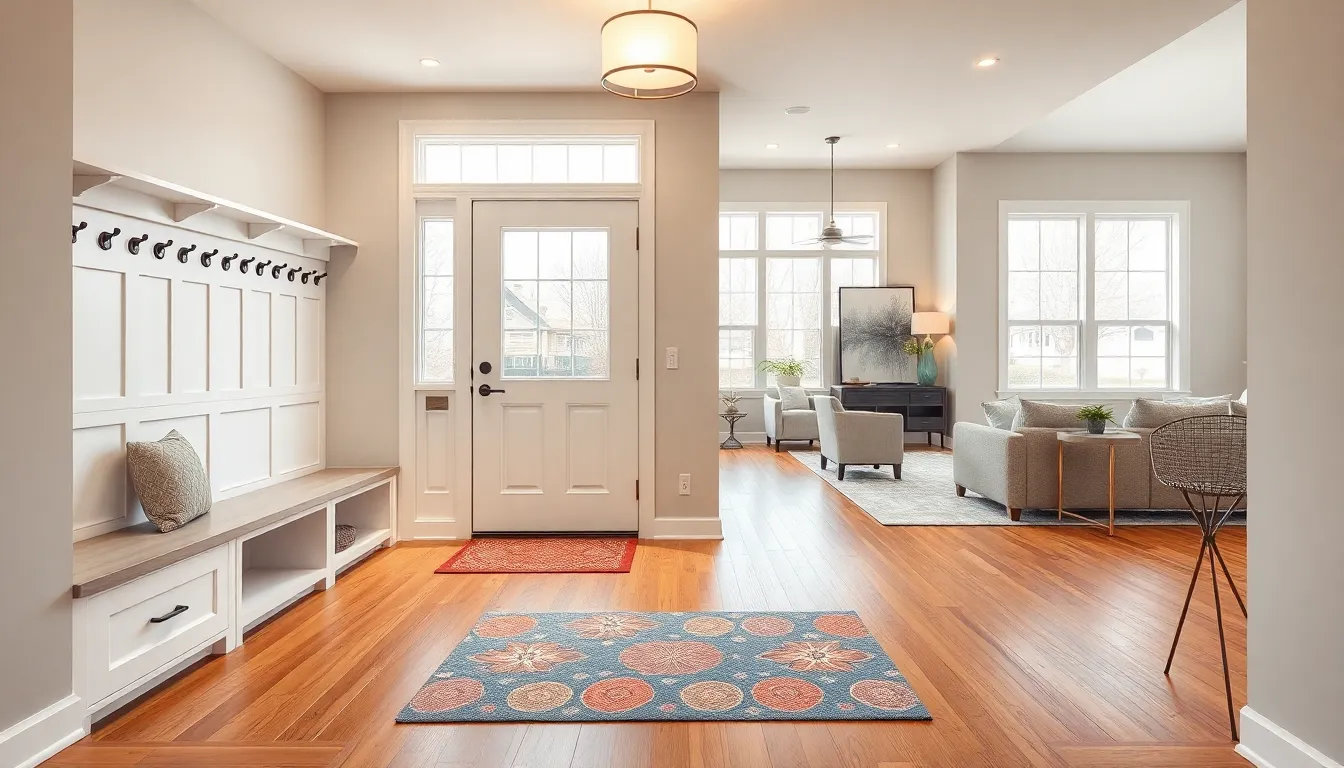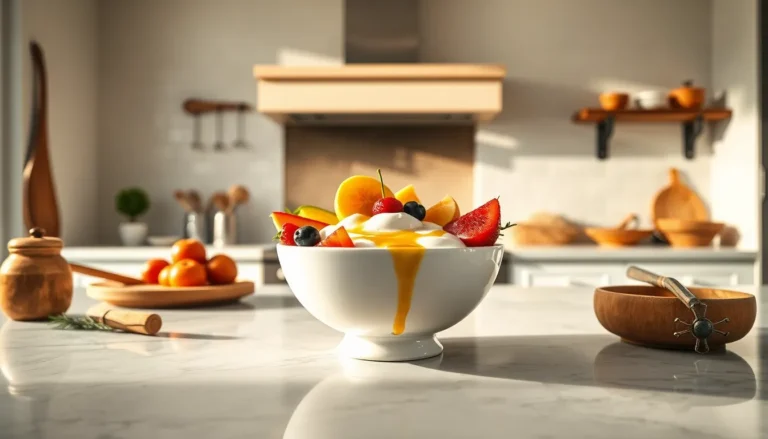Split-level homes often get a bad rap, but with the right renovation ideas, they can transform into stylish havens that make everyone else green with envy. Imagine stepping into a space that flows seamlessly, where each level feels like a cozy nook rather than a confusing maze. It’s time to embrace the quirks of these unique layouts and turn them into design opportunities.
Table of Contents
ToggleOverview Of Split Level Homes
Split-level homes feature multiple levels connected by short sets of stairs, creating distinct living spaces that enhance functionality. These designs typically include three or four levels, with upper and lower areas often serving different purposes, such as sleeping and entertaining. Commonly built between the 1950s and 1970s, they offer a unique aesthetic that’s both modern and nostalgic.
Each level has its characteristics, which can benefit from thoughtful renovation. For instance, the lower level often includes a family room or recreation area, making it ideal for gatherings. The entryway, usually situated in the central part of the home, serves as a transition space that can be enhanced to increase flow.
Many homeowners find that natural light can play a crucial role in split-level homes. Larger windows or open staircases help illuminate various areas and offer visual connections between levels. Well-placed lighting fixtures can complement these designs, emphasizing architectural features and creating inviting spaces.
Landscaping also contributes to the overall appeal of split-level homes. A well-maintained yard or garden increases curb appeal, adding value. Outdoor terraces or patios can serve as extensions of the indoor living space, encouraging seamless transitions between environments.
Practical renovation ideas include updating finishes and materials to create a cohesive and modern look. Choosing a consistent color palette across levels fosters unity. Additionally, integrating built-in storage solutions can maximize space utilization, addressing potential clutter while enhancing design aesthetics.
Understanding the unique layout of split-level homes allows for a creative approach to renovation. Tailoring designs to individual needs can transform these spaces into functional, stylish, and inviting homes.
Popular Renovation Ideas

Split-level homes present unique opportunities for renovations that enhance both aesthetics and functionality. Homeowners can focus on distinct areas to create inviting spaces.
Updating The Entryway
Updating the entryway creates an inviting first impression. Consider replacing old doors with modern designs to improve energy efficiency and style. Adding a new light fixture brightens the space, increasing visibility. Incorporating built-in storage solutions, like benches or hooks, offers practicality for shoes and bags. Utilizing paint colors that harmonize with the rest of the home can also help achieve a cohesive look. Installing durable flooring options, such as tile or hardwood, adds longevity and appeal. A fresh welcome mat can provide a subtle but effective finishing touch.
Enhancing The Living Room
Enhancing the living room ensures it becomes a central hub for relaxation and socializing. Open concept layouts are ideal for increasing flow between spaces. Consider installing large windows to maximize natural light, creating a bright atmosphere. Replacing outdated flooring with hardwood or carpet upgrades can add warmth and comfort. Incorporating built-in shelves or cabinetry promotes organization while showcasing decor. Switching to modern, versatile furniture improves both function and style, allowing easy rearrangement for different occasions. Fresh coats of paint in neutral tones can rejuvenate the look, making the space feel updated.
Kitchen Transformation Tips
Renovating the kitchen in a split-level home can significantly enhance its appeal and functionality. Various strategies exist to optimize the space while maintaining a cohesive design.
Open Concept Designs
Incorporating open concept designs encourages flow between spaces. Removing walls can create a seamless transition from the kitchen to the dining or living area. Not only does this increase the perception of space, but it also enhances natural light throughout the home. Consider using a large kitchen island as a central feature for cooking and dining. Integrating bar stools allows family and friends to gather while meals are prepared. Emphasizing continuity with consistent flooring materials throughout connected areas promotes visual harmony.
Modernizing Appliances
Modernizing appliances contributes to both aesthetics and functionality. Opt for energy-efficient models that blend style with sustainability. Stainless steel finishes not only look contemporary but are also easy to maintain. Choosing built-in appliances, such as refrigerators and ovens, creates a streamlined look while conserving space. Incorporating smart technology, such as programmable thermostats and touch-controlled features, adds convenience. New appliances not only enhance performance but also positively impact the overall kitchen design, making it a more enjoyable space for daily activities.
Bathroom Renovation Suggestions
Revamping bathrooms in split-level homes can enhance their value and aesthetic appeal. Innovative designs turn these essential spaces into relaxing retreats.
Spa-like Retreats
Creating spa-like retreats transforms bathrooms into relaxation zones. Consider incorporating features such as a freestanding soaking tub or a spacious walk-in shower. Large tiles and calming colors set a soothing ambiance, while mirrors with built-in lighting increase functionality. Adding elements like rainfall showerheads or heated floors heightens comfort and luxury. Integrating plants can also promote tranquility, improving air quality. Use natural materials to evoke a sense of nature, further enhancing the spa experience.
Space-saving Solutions
Maximizing limited bathroom space in split-level homes requires strategic design approaches. Floating vanities and wall-mounted shelves help create an illusion of a larger area. Utilize corner sinks or compact fixtures to save valuable floor space. Opt for sliding or pocket doors for access, conserving room for movement. Consider built-in storage solutions, like recessed medicine cabinets, to keep essentials organized without crowding. Vertical storage options, such as tall cabinets, maximize height and offer additional organization. Efficient layouts maximize functionality while maintaining a clean, open feel.
Landscaping And Outdoor Upgrades
Landscaping plays a crucial role in enhancing the curb appeal of split-level homes. Incorporating diverse plant selections, such as perennials and native species, adds color and texture throughout the seasons. A well-maintained lawn complements these elements, providing an inviting backdrop.
Outdoor upgrades can extend living space beyond the home. Creating a deck or patio encourages outdoor gatherings and dining experiences. Homeowners can choose materials like composite decking for durability, which requires less maintenance than traditional wood.
Incorporating walkways enhances accessibility. Stone or paver paths lead visitors seamlessly from the driveway to the front door. These features also create defined areas for planting and outdoor furniture.
Lighting fixtures in outdoor spaces increase safety and ambiance. Solar-powered lights along walkways and spotlights on landscaping highlight key features during nighttime. Such additions make outdoor spaces usable after dark.
Horizontal fences can define boundaries while maintaining visual openness. Materials like wood or vinyl offer aesthetic options, blending with the home’s style. Additionally, ornamental gates contribute an elegant touch.
Water features, such as fountains or small ponds, create soothing sounds and attract wildlife. These elements enhance tranquility in outdoor environments. Installing a small fire pit also provides warmth for evening gatherings.
Utilizing vertical gardens maximizes space, especially in smaller outdoor areas. Vertical planters can house herbs or flowering plants, introducing greenery without occupying ground space. These gardens not only beautify but also improve air quality.
Finally, attention to hardscaping elements solidifies aesthetic appeal. Stone walls or retaining walls can create terraced gardens, adding dimension to the landscape. By strategically designing outdoor areas, homeowners can enrich their living experience within split-level homes.
Transforming a split-level home into a stylish and functional space is entirely achievable with thoughtful renovation ideas. By focusing on creating a seamless flow between levels and maximizing natural light, homeowners can enhance the unique layout to their advantage.
Updating key areas like the entryway, living room, kitchen, and bathroom not only boosts aesthetic appeal but also increases overall functionality. Outdoor enhancements can further elevate curb appeal and create inviting spaces for relaxation and gatherings.
With the right approach, split-level homes can become modern retreats that reflect personal style while meeting practical needs. Embracing the potential of these homes opens the door to endless design possibilities.


